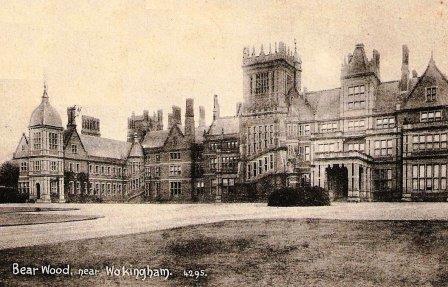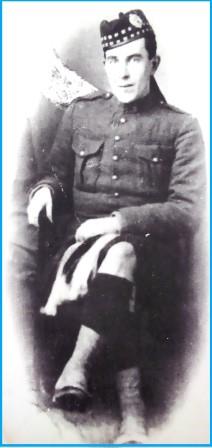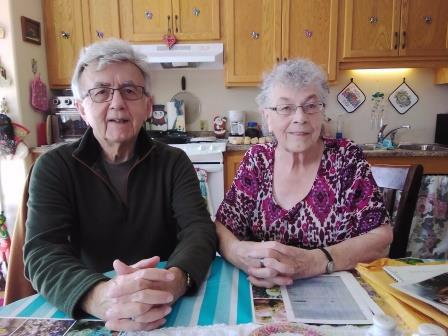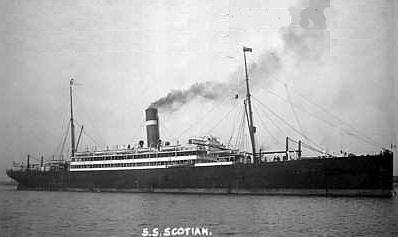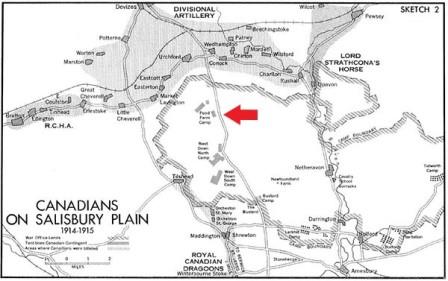March 29, 2024. In Part 1 of the WWI letters of Lawrence Ivy MARSHALL, of Covehead, Prince Edward Island, which had been shared by his granddaughter, Connie Birt Paynter, Lawrence was among the first Canadians to volunteer for WWI in 1914. After his initial training in Valcartier, Quebec, he informed his family that he was about to go overseas. (See https://onthewarmemorialtrail.com/2024/03/02/on-the-war-memorial-trail-the-wwi-letters-of-lawrence-ivy-marshall-part-1-valcartier-camp/)
In Part 2, Lawrence described his experiences aboard one of the first troop ships to England. (See https://onthewarmemorialtrail.com/2024/03/08/on-the-war-memorial-trail-the-wwi-letters-of-lawrence-ivy-marshall-part-2-the-voyage-to-england/)
In Part 3, Lawrence was on the front lines in trenches in Belgium and France, when he dislocated his elbow and was sent back to England for treatment. (See https://onthewarmemorialtrail.com/2024/03/15/on-the-war-memorial-trail-the-wwi-letters-of-lawrence-ivy-marshall-part-3-in-the-trenches/)
In Part 4, Lawrence spent weeks in England recuperating before returning to active service at the front …. until he was wounded and sent back to England. (See https://onthewarmemorialtrail.com/2024/03/21/on-the-war-memorial-trail-the-wwi-letters-of-lawrence-ivy-marshall-part-4-back-at-the-front/)
Now, in Part 5, Lawrence’s story concludes as his wartime service in England ended, and he returned to Canada with a war bride….
…Lawrence worried that his brother Merrill would be sent to the front….
As 1916 turned into 1917, Lawrence remained in England, working at the Canadian Convalescent Hospital at Wood Cote Park in Epsom, Surrey. His younger brother Merrill was also in England.
On January 29, 1917 in a letter to his father, he explained that he had received “…a letter from Merrill yesterday. He is still at Shorncliffe and having a good time of it….”
After Lawrence’s experiences in France and Belgium, he worried that his brother might also be sent to the front. “… I hope and pray that he never sees the trenches, because you have a pretty slim chance of getting back alive out there, and by the talk of things there are going to be harder fighting out there this spring than there has been yet at all. They are putting every man that’s fit out there this spring and try to make one big drive for the last time, but I don’t think that there is much use of doing it. Germany ain’t beat yet nor won’t be for a while…”
Lawrence may have heard inklings of the preparations for what we would come to know as the Battle of Vimy Ridge. His worries continued as expressed in a February 11, 1917 letter to his father. “…Have you heard from Merrill since he went to France? I have been expecting a letter from him the last week, but did not receive any. He will find quite a difference over there to what he had in England, but still he will get a good job as he is a signaler. He may never have to go into the trenches at all….”
…Lawrence was devastated to learn his brother had died during the Battle of Vimy Ridge….
On April 16, 1917, Lawrence wrote his mother to let her know that he’d received “…a letter from Merrill. He was fine when he wrote. He said that it wasn’t too bad out there yet. I only hope that he will come through it all safe and sound….” Unfortunately, by the time Lawrence wrote this letter, Merrill was dead. He had died April 9, 1917 during the Battle of Vimy Ridge. (See https://onthewarmemorialtrail.com/2023/06/14/on-the-war-memorial-trail-the-wwi-signaller-from-covehead-killed-during-the-battle-of-vimy-ridge/)
By May 11, 1917, Lawrence had heard about Merrill and wrote to his parents. “…I suppose that you have heard by this time about poor Merrill being killed on Easter Monday…I know what a shock it will be to you all.…Something was telling me all the time that he was gone. But never mind….he was a hero and died for his country….”
…Lawrence fell in love….
On May 26, 1917, Lawrence wrote his mother from D Company, No. 1 Platoon Regiment, 1st Canadian Command Depot, St Leonard’s on Sea, Sussex, England: “…I am not at Epsom now. Am down on the south coast of England at my command depot. It is a very nice place but they drill you pretty hard here….”
When he was sent to Epsom, Lawrence met Evelyn ‘Eve’ Martha Williams. At the time, he already had an English girlfriend named Ada, who his parents expected he would marry. But love takes its own path, and Lawrence had to inform his family that he and Ada had broken up. “...The one that I have now is a dear little girl …. I loved this girl near nine months and kept it to myself and tried to keep Ada but couldn’t love two girls when you love one more than the other….”
…Evelyn was a volunteer with the Women’s Legion….

Evelyn ‘Eve’ Martha Williams. (Photo courtesy of Connie Birt Paynter. Photo colourization by Jim Paynter)
Evelyn was a member of the Women’s Legion, Royal Air Force. The Women’s Legion was a volunteer organization that began in 1915. Volunteers wore military style uniforms and took on various duties. (See https://livesofthefirstworldwar.iwm.org.uk/community/3891)
Members of the Women’s Legion, Royal Air Force, worked as drivers, despatch riders, clerks, or telephonists. They were billeted in women’s accommodations, usually near the places where they worked. (See http://www.rafhornchurch.thehumanjourney.net/History/women.htm)
Lawrence knew his parents were still grieving the loss of Merrill and hoped that his news would be welcome. “…She is still at Epsom yet. She is a girl doing her bit too….I know how you all feel at home….I feel bad enough myself…. The only comfort I had was Eve, my girl…”
The daughter of a soldier, William ‘Edwin’ Williams, Evelyn was born in India and would have known how to deal with wartime loss.
…Lawrence and Evelyn married in England….
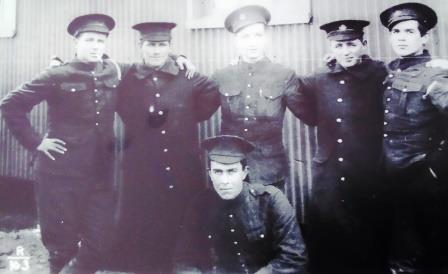
1917 group photo with Lawrence Ivy Marshall, bottom centre. (Photo courtesy of Connie Birt Paynter)
A November 24, 1917 letter from Lawrence to his father, written from No. 1 Company 5th Reserve Battery, West Sandling, Kent, indicated that war had taken it’s toll. “…about that photo I sent you of some of the boys, you were right, I am in the middle on my knees. It is hard to tell it’s me in that but it is me alright. I guess that I don’t look the same as I used to….”
On April 29, 1918, 26 year old Lawrence and 23 year old Evelyn were married at the parish church in Figheldean, Wiltshire.
…Lawrence and Evelyn travelled to Canada aboard HMS Melita….
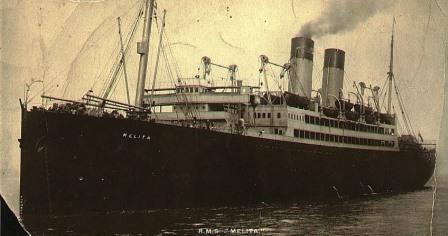
HMS Melita. (Photo source: wwiwarbrides.blogspot.com)
Just over a year after their marriage, Lawrence and Evelyn left the United Kingdom for Canada on May 5, 1919, aboard HMS Melita. The ship, with soldiers and military dependents, departed from Liverpool and arrived in Quebec City, Quebec on May 12, 1919. Two days later, Lawrence was officially discharged from military service in Quebec City.
…Lawrence and Evelyn lived in Covehead…
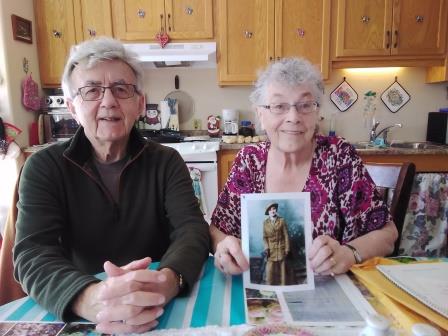
Pieter with Connie Paynter, who is holding a photo of her grandmother, Evelyn Marshall. (Photo credit: Daria Valkenburg)
Lawrence returned to Covehead, with Evelyn, and they raised three children. Their granddaughter Connie recalled that Evelyn was known as “…Little Eve. She became a midwife on Prince Edward Island and worked with Dr. Wendell MacDonald…”
Lawrence “…farmed in West Covehead and Marshall’s Dam is named after him. He was a carpenter and a fantastic gardener….”

Lawrence Ivy Marshall drying fish on Prince Edward Island. (Photo courtesy of Connie Birt Paynter. Photo colourization by Pieter Valkenburg)

Grave of Lawrence Ivy Marshall at West Covehead United Church Cemetery in West Covehead, Prince Edward Island. (Photo source: http://www.findagrave.com)
Lawrence died on November 2, 1959 and is buried at West Covehead United Church Cemetery, which is also known as St. James United Presbyterian Cemetery. Evelyn died on February 26, 1982 and is buried in the same cemetery.
This concludes the 5 part series on the WWI letters of Lawrence Ivy Marshall. Thank you to Connie Paynter for providing photos and sharing letters written by her grandfather. If you can identify any of the other soldiers in the 1917 group photo, please let us know.
Do you have photos or information to share? Email Pieter at memorialtrail@gmail.com, comment on the blog, or tweet to @researchmemori1.
© Daria Valkenburg
….Want to follow our research?….
If you are reading this posting, but aren’t following our research, you are welcome to do so. Our blog address: https://onthewarmemorialtrail.com/
 4 countries, 6 weeks, 7,000 km – an unforgettable war memorial journey in Europe…. Daria’s book ‘No Soldier Buried Overseas Should Ever Be Forgotten‘ is available in print and e-book formats. Net proceeds of book sales help support research costs and the cost of maintaining this blog. For more information see https://nosoldierforgotten.com/
4 countries, 6 weeks, 7,000 km – an unforgettable war memorial journey in Europe…. Daria’s book ‘No Soldier Buried Overseas Should Ever Be Forgotten‘ is available in print and e-book formats. Net proceeds of book sales help support research costs and the cost of maintaining this blog. For more information see https://nosoldierforgotten.com/
You are also invited to subscribe to our YouTube Channel: On The War Memorial Trail With Pieter Valkenburg: https://www.youtube.com/channel/UCJ591TyjSheOR-Cb_Gs_5Kw.
Never miss a posting! Subscribe below to have each new story from the war memorial trail delivered to your inbox.

